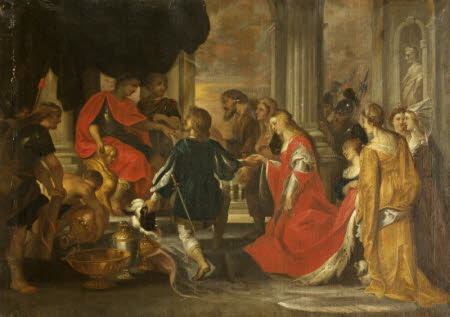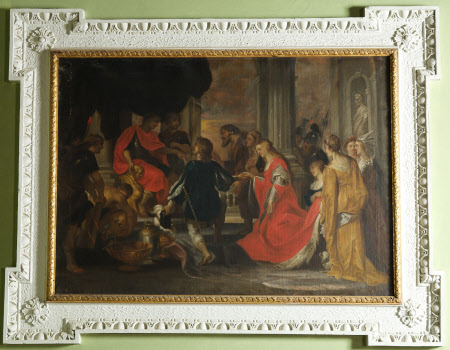The Continence of Scipio
Victor Wolfvoet II (Antwerp 1612 - Antwerp 1652)
Category
Art / Oil paintings
Date
1600 - 1699
Materials
Oil on canvas
Measurements
819 x 1156 mm (32¼ x 45½ in)
Place of origin
Antwerp
Order this imageCollection
Lacock, Wiltshire
NT 996275
Caption
This picture is a copy after Rubens, which he painted in around 1620, which was destroyed by fire. It shows the general, Scipio, who after the capture of New Carthage in Spain, restored a beautiful captive to her betrothed, even adding as a wedding present the gold her parents had brought as a ransom. The story is a prime instance of political calculation (Scipio had learned that the fiancé was an influential nobleman) and sexual abstinence. In Rubens’s picture, the couple are shown kneeling in thanks (not in custody, as in many representations), and the ransom has already been returned. Scipio is shown directing his compassion towards the girl. The dress of the retinue is loosely based on 15th century Burgundian dress (not Roman, but of an historical flavour). This, and the Rape of the Sabines appear to be 18th-century, perhaps English. They are probably by the same hand, united by their rigid use of vermilion in the drapery.
Summary
Oil painting on canvas, The Continence of Scipio by Victor Wolfvoet II (Antwerp 1612- Antwerp 1652), after Sir Peter Paul Rubens (Seigen 1577 - Antwerp 1640), 17th century. The Roman General is enthroned to the left, gesturing to the pardoned maiden, who is accompanied by her parents to her right, and fiancé to her left. She is attended by a retinue of maidservants, one of whom holds her ermine-lined train, under which hides a small dog. Scipio is attended by soldiers, one of whom, to the left, bears the fasces. Before him, a slave sets down an urn alongside other golden vessels, which served as ransom. Two soldiers assume a voyeuristic position behind a pillar to the right. The scene is set before a colonnaded architectural backdrop, with a statue set into a niche to the right. The original oil sketch is in the Kunstsammlung Rudolf August Oetker, Bielefeld.
Full description
Rubens’s original picture of circa 1620, was destroyed by fire, in London, in 1836. Its appearance is perhaps best known through the copy possibly by Theodoor Boeyermans (whereabouts unknown, but repd. in E. McGrath, Subjects from History, London, 2007, fig.178), and an oil sketch by Rubens himself (Bielefeld, Professor A. Oetéke, op.cit. supra, fig.177). Another version, after Rubens, is in a Belgian private collection, and there exists an oil sketch, also after Rubens, whose whereabouts are unknown. It was engraved by Jean Dambrun, after A. Borel, after Rubens (made when Rubens’s picture was in the collection of the Duc d’Orléans); Schelte à Bolswert after Rubens (with greater height and width). Scipio, after the capture of New Carthage in Spain, restored a beautiful captive to her betrothed, Allucius (or Indibilis, according to Valerius Maximus), even adding as a wedding present the gold her parents had brought as a ranson (see Livy, Ab urbe condita, XXVI.50); Valerius Maximus, Dicta et facta, IV.iii.1); and Polybius, Histories, X.19). The story is a prime instance of political calculation (Scipio had learned that the fiancé was an influential nobleman) and sexual abstinence (he was famed for his irrepressible lasciviousness). In Rubens’s picture, the couple are shown kneeling in thanks (i.e. not still in custody, as in many representations), and the ransom has already been returned. Scipio is shown directing his magnaminity towards the girl. As McGrath points out in op.cit. supra (no.49, p.257ff.) the dress of the Celtiberian retinue is loosely based on 15th century Burgundian dress (i.e. not Roman, but of an historical flavour). The Lacock picture was probably painted after the Schelte à Bolswert engraving, which bears features not found in any of the other known versions: the composition has been extended to the sides (incorporating fully the statue in the niche, and maidservant’s headdress to the right; more of the soldier’s to the left; a higher elevation of architecture; and a greater expanse of foreground); the addition of the dog underneath the train of the dress; the urns are here positioned differently, and the handle of the bowl to the front has been shifted to the side; the statue in the niche here has more Augustan features (he is not bearded); and even the facial features bear the same pointed, or pinched demeanour. The only difference between the engraving and the Lacock picture is that the tiled floor and patterned carpet in the former, have here been left undecorated. [Quaere: can this be the picture illustrated in McGrath (fig.180), whose whereabouts are unknown? This too features the dog, but appears cropped at the top, and perhaps to sketchy, or abraded.] This, and the Sabine pictures, appear to be 18th-century, perhaps English. They are probably by the same hand, united by their rigid use of vermilion in the drapery.
Provenance
Given by Matilda Theresa Talbot (formerly Gilchrist-Clark) (1871 – 1958), who gave the Abbey, the village of Lacock and the rest of the estate to the National Trust in 1944, along with 96 of the family portraits and other pictures, in 1948
Credit line
Lacock Abbey, The Talbot Collection (National Trust)
Makers and roles
Victor Wolfvoet II (Antwerp 1612 - Antwerp 1652), photographer after Sir Peter Paul Rubens (Siegen 1577 - Antwerp 1640), artist
References
Martin 2016 Gregory Martin, 'Two Antwerp cabinets decorated by Victor Wolfvoet II', with Checklist by Bert Schepers, The Burlington Magazine, October 2016, no. 1363, vol. CLVIII, pp. 793-802

